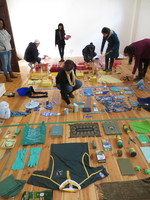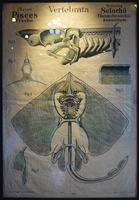Items
Site
The Medicine Chest
keywords is exactly
studying
-

Playtone
Resulting from a 5-day taxonomy workshop which ran from 14 – 18 July 2014 as part of the Honours in Curatorship programme, the PLAYTONE exhibition depicts one of the various exercises students were asked to perform. Colours were allocated to groups, and students instructed to photograph all colour-coded objects during their daily routines, which were then classified using the PANTONE system. In addition to this, students also generated a selection of words they associated with their allocated colours and accumulated colour-coded personal belongings. Participants: Matthew Bradley, Annchen Bronkowski, Thea Ferreira, Sakhisizwe Gcina, Gail Gunston, Sharne McDonald, Mari McFarlane, Mosa Motaung, Thandiwe Msebenzi , Chloe Obermeyer, Bianca Packham, Lindelwa Pepu, Tazz Rossouw, Phenduliwe Sibisi -

'How Zoology was taught in the past'
The wall text accompanying these charts in the Hunterian museum, Glasgow, reads: "In the late 19th and 20th centuries, before the advent of colour slides that could be projected, the teaching of Zoology depended heavily on the use of wall charts to illustrate lectures. They were hung on a special pulley system at the front of the lecture theatre and, because of their large size, could be clearly seen from the back of the class". -

Scientific atlases
"Used from the 18th to the 20th centuries, the scientific atlases provided, for example, simplified, generalised and idealised versions of the objects of anatomy, physiology, botany, palaeontology and astronomy, to name a few, guiding the student and practitioner to what was worth looking at, how it looked and, perhaps most important of all, how it should be looked at (Daston & Galison 2007:23). The establishment and representations of these working sets of objects, and the standardised procedures for studying them, thus extended the initial influence exercised on the individual traveller in the field. By controlling the very act of seeing and by creating a sense of individuals working as members of academic communities, the atlases shaped the subjects and the objects of their disciplines. Processes initiated in the field and reinforced in institutions, societies and museums laid the foundation for procedures still used by the disciplinary insiders of university departments today" (Liebenberg 2021: 111).


